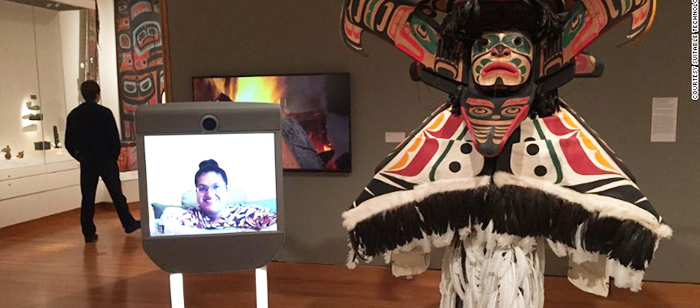
CSEE Ph.D. student Kavita Krishnaswamy was featured in a recent CNN story, Will robots help the bedridden see the world?. She has been getting a lot of visibility in the last few months via a collaboration with Suitable Technologies, a Palo Alto based company that makes ‘telepresence robots’. They loaned the department one of their high-end Beam systems last Fall to use in our robotics related research, lead by professors Tim Oates and Cynthia Matuszek, and have been inviting Kavita to use their systems in various ways.
 For example she presented her dissertation proposal in December via Beam, participated in a panel at the Consumer Electronics Show show in January, has been visiting museums via Beam this month, helped lead a debate on the ethics of brain-computer interfaces this past Monday, and will take part in in a SWSX panel in March.
For example she presented her dissertation proposal in December via Beam, participated in a panel at the Consumer Electronics Show show in January, has been visiting museums via Beam this month, helped lead a debate on the ethics of brain-computer interfaces this past Monday, and will take part in in a SWSX panel in March.
Here is an excerpt from the CNN story:
“A PhD candidate at the University of Maryland, Baltimore County, Krishnaswamy has spinal muscular atrophy and requires assistance 24 hours a day. She was able to make the museum trips using a Beam telepresence robot — a remotely controlled 16-inch screen mounted five feet above motorized wheels.
…
“I really enjoy the autonomy. It allows me to focus in on the things I want to see,” said Krishnaswamy. “And it’s not controlled by somebody else. I really like being independent.”Since her first experience using a Beam to attend a computing conference in Seattle, Krishnaswamy says her life has changed drastically. She has more confidence and her calendar is suddenly filled. In a single day this week, she will take part in a debate on her campus, drop in on the Mobile World Congress in Barcelona, and be in Washington D.C. for the Human Robot Interaction conference.
Krishnaswamy has never had the ability to stand. The Beam puts her at eye-level and gives her a new perspective on the world, she says.”